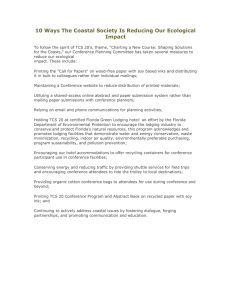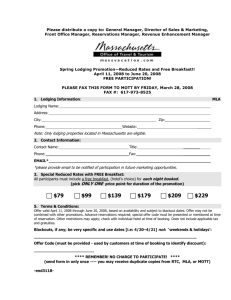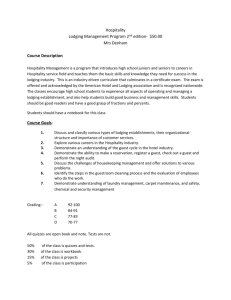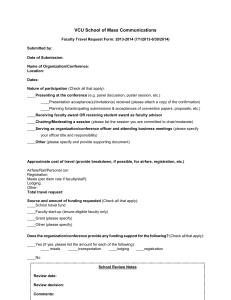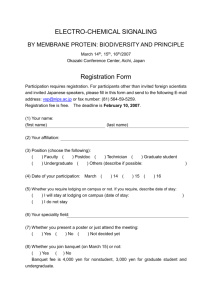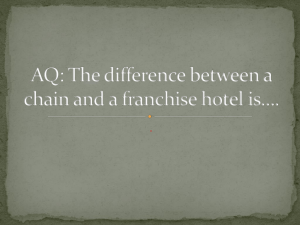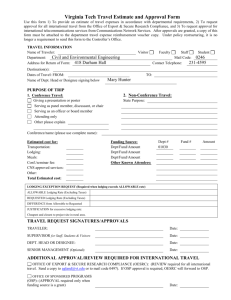Indoor Air Quality - Florida Green Lodging Program
advertisement
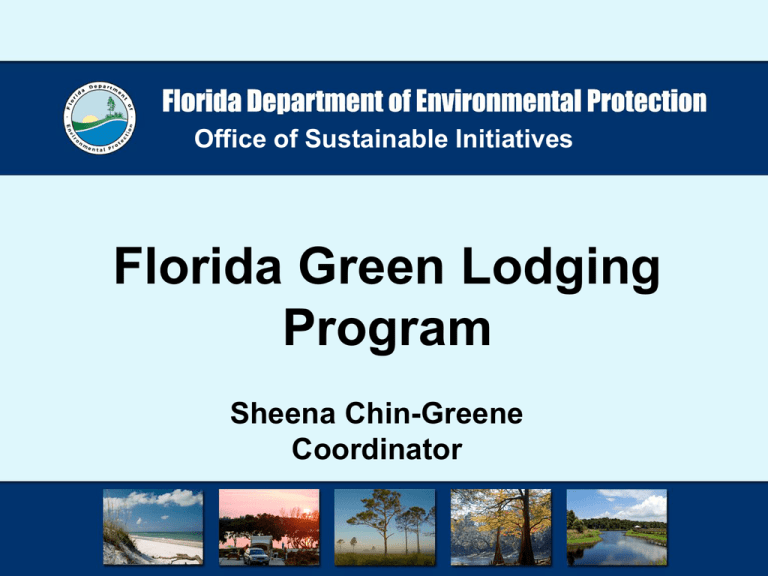
Office of Sustainable Initiatives Florida Green Lodging Program Sheena Chin-Greene Coordinator Our Topics for Today • • • • Introduction to the Florida Green Lodging Program Brief History Designation Process Overview Areas of Operations 6/29/2015 2 What is the Florida Green Lodging Program? The Florida Green Lodging Program is a voluntary, nonregulatory effort by the Florida Department of Environmental Protection (DEP) that encourages the lodging industry to: • • • • Conserve water and energy Minimize waste generation and increase recycling Improve indoor air quality Implement environmentally friendly purchasing and pollution prevention strategies • GOAL: Help Florida’s lodging industry become sustainable while lowering operating costs 6/29/2015 3 By the Numbers... • • • 407,627 rooms available for lodging 4,462 lodging-type facilities 2014 tourism related spending = $82.0 billion* • • • • • Lodging – $21.2 billion (25.8% of total) Dining – $36.3 billion Admissions – $13.9 billion Other – $10.7 billion $128.10 = average amount spent by each domestic visitor per day in Florida* *Courtesy of Visit Florida’s 2014 Florida Visitor Data 6/29/2015 4 Benefits of Sustainable Practices in the Hospitality Industry Increases to the “Triple Bottom Line”: Planet • Reduce water use, energy consumption and waste generation Profits • Waste = Lost Profits People • Companies and non-governmental organizations are requesting green meetings and conferences 6/29/2015 5 A Little History… • • • The Florida Green Lodging Program was launched in 2004 as part of the DEP’s Pollution Prevention Program 1st four hotels were designated on March 10, 2004 • Hilton University of Florida Conference Center • Hyatt Regency Coconut Point Resort and Spa • Disney’s Boardwalk Resort • Disney’s Coronado Springs Resort From March 10, 2004 to July 20, 2007, at total of 25 properties were designated 6/29/2015 6 A Little History… • Program underwent changes in July 2009 to improve not only the environmental performance of designated properties, but also to increase the overall operating efficiency and customer service aspects of the program. • These changes have resulted in increased environmental protection and a streamlined program. • On August 1, 2012, a partnership was launched with Audubon International’s Green Lodging Program to further recognize the top environmental performers in the state lodging sector • Currently 737 designated properties are in the program 6/29/2015 7 Reasons for Growth • Section 4 of Executive Order 07-126 – required that “as of January 1, 2008, state agencies and departments under the direction of the Governor could not contract for meeting or conference space with hotels that had not received the DEP’s Green Lodging program designation……except when certified by the Governor or the responsible agency head that no viable alternative existed. • Section 286.29, Florida Statutes: The Energy, Climate Change and Economic Security Act of 2008 – stressed the above through House Bill 7135and included reducing greenhouse gas emissions and investing in alternative energy technologies 6/29/2015 8 About the Designation… • Florida Green Lodging designation is valid for 3 years • All other properties must renew their designation within 3 years of their designation date. 6/29/2015 9 About the Renewal… How does a facility renew its designation? • Must have submitted environmental performance data annually • • Complete the renewal designation application • Must consistently maintain compliance with program requirements Must implement at least two new environmental practices from any of the five areas of sustainable operations every 3 years 6/29/2015 10 Compliance with Program Criteria • Compliance with the program criteria is checked through random spot audits • Properties are notified by letter once they have been selected • A Green Lodging representative will contact the property to schedule the audit and discuss any necessary items 6/29/2015 11 Spot Audit Process • Audits consist of the following: • Brief introductory meeting • Document review • Facility walk-through • Properties generally are notified of the audit results within 4 weeks • If a property cannot or refuses to correct deficiencies that are noted in a timely manner, they will be removed from the program 6/29/2015 12 Current Designation Process • Conduct a property assessment and implement environmental practices in five areas of operations: 1. 2. 3. 4. 5. • Communication and Education Waste Reduction, Reuse and Recycling Water Conservation Energy Efficiency Indoor Air Quality Complete the designation application • Details requirements and provides Best Management Practices and Technical Assistance to help facilities achieve designation • 6/29/2015 http://www.dep.state.fl.us/greenlodging/files/designationapplication1.pdf 13 Current Designation Process • Palm Rating System • • • • One Palm: Two Palm: Three Palm: Four Palm: 6/29/2015 212 – 398 points 399 – 557 points 558 – 717 points 718 – 796 points 14 Application Review Process • In most cases, applications and documentation should be submitted electronically • Once received, applications are usually reviewed within 2 business days • If any correction is needed: • • Email sent with specific items that need to be corrected • Highlighted copy of application will also be returned • Once complete, resubmit application No correction needed: • Congratulations email will be sent to applicant • Certificate and Green Lodging flag will be sent within 1 month 6/29/2015 15 Areas of Operation • • • • • Communication and Education Waste Reduction, Reuse and Recycling Water Conservation Energy Efficiency Indoor Air Quality 6/29/2015 16 Communication and Education • • • Communicate your environmental efforts to your constituents! Show environmental benefits at your facility and where your constituents live, work and play Sample Practices • Use of facility’s in house channel to communicate environmental messages • Establish a “Green Team” to evaluate and improve environmental initiatives • Provide a way for guests and staff to provide feedback • Have a formal written comprehensive environmental policy, including a purchasing policy that addresses environmental issues 6/29/2015 17 Waste Reduction, Reuse and Recycling • • Reduce materials at their source, recover, reuse and recycle • Prevents pollution and reduces or eliminates treatment and disposal costs Sample Practices • If applicable, recycle items such as plastic, aluminum cans, steel cans, glass, office paper, newspapers, magazines, ink cartridges, fluorescent blubs, electronics, etc. • Provide recycling bins for guests at multiple locations throughout the property • Institute one or more of the following activities: bulk purchasing, reduced packaging, manufacturer take-back • Use reusable goods in place of disposable goods 6/29/2015 18 Water Conservation • • • Lessen the impact a lodging facility has on the environment Protect our very reason visitors come to Florida: the beautiful beaches, rivers, springs and lakes Sample Practices • Use a preventative maintenance schedule to find and repair leaky faucets, toilets and pipes (restrooms, kitchen, exterior, etc.) • Offer a towel and linen reuse program • Use low flow faucets, showerheads and toilets • Install and set timers for optimum water conservation 6/29/2015 19 Energy Efficiency • • • • • Lodging facilities have significant opportunity to: Reduce energy use Reduce costs Keep equipment in optimum condition Sample Practices • Have your utility provider conduct an energy assessment and track usage • Have a preventative maintenance schedule to clean and maximize efficiency in appliances • Use energy efficient lighting • Encourage guests and staff to walk, bus and bicycle to and from the hotel 6/29/2015 20 Indoor Air Quality • • • • • Increase energy efficiency Reduce exposure to health-related liabilities Positive impacts on the “bottom line” Higher employee and guest satisfaction Sample Practices • Use at least two environmentally friendly cleaners • Use air filters with a Minimum Efficiency Reporting Value (MERV) of 8 or better • Clean all air handler units and coils annually and have a preventative maintenance schedule • Routinely monitor ceiling tiles, wallpaper, shower curtain or other absorbent surfaces for signs of mold and replaces as necessary 6/29/2015 21 Common Mistakes and Problems … In the Application and Review Process • Not enough supporting documentation • Include all necessary documentation, as indicated by criteria • Examples include pictures, scanned copies of forms (especially those for preventative maintenance programs), meeting minutes, etc. • Incomplete or incorrect environmental performance data • Need 12 months of historical data for energy use, water consumption and waste generation • 6/29/2015 New properties need to supply as much historical data as possible 22 Suggestions for Success • Obtain Buy-in from Top Management • Establish a “Green Team” • Constantly Evaluate Your Environmental Performance 6/29/2015 23 Available Assistance • • Marketing: • Designated facilities are featured on the Florida Green Lodging Web site. • Designees are granted exclusive use of the green marketing tool kit. http://www.dep.state.fl.us/greenlodging/toolkit.htm Technical Assistance: • 24/7 Web access to Best Management Practices, Technical Assistance and other “green” resources. • DEP hosted Webinars and workshops to continue employee education. 6/29/2015 24 Florida Green Lodging Program Contact Sheena Chin-Greene Program Coordinator GreenLodging@dep.state.fl.us 850.245.2116 or 904.256.1513 6/29/2015 25
